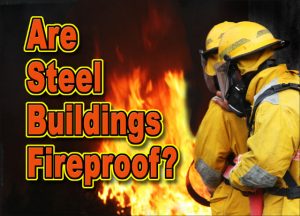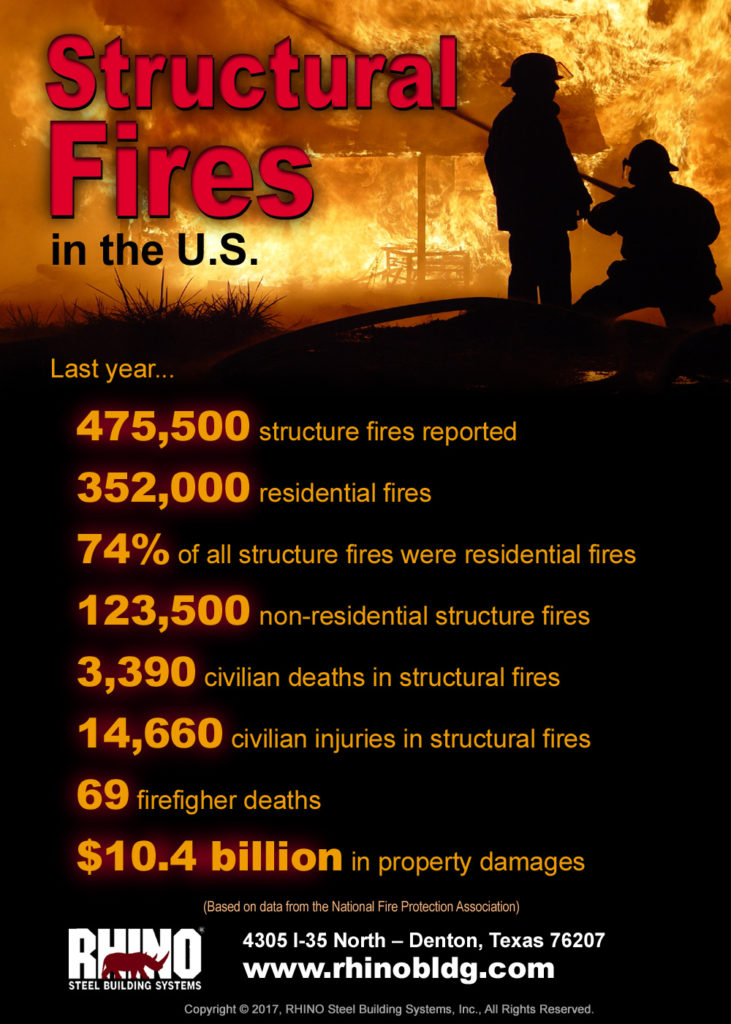Understanding Fire-Related Building Terms
If you’ve followed this blog very long, you have doubtless read about the fire-resistant qualities of pre-engineered metal buildings. But what exactly does “fire-resistant” mean?
What Are Fire Resistance Ratings?
 The fire standard for most building codes comes from tests conducted by the American Society for Testing and Materials (ASTM). The ratings are based on how long a particular building material or system resists the spread of the fire and sustains its structural integrity.
The fire standard for most building codes comes from tests conducted by the American Society for Testing and Materials (ASTM). The ratings are based on how long a particular building material or system resists the spread of the fire and sustains its structural integrity.
In other words, how long a building will stand before collapsing in a typical structural fire.
ASTM tests various construction elements of building materials— beams, columns, floors, roofs, and walls— under fire. The fire resistance of the component generally earns a rating of one to four hours. The higher the rating, the more fire resistant the structure is.
What Is the Difference in Fireproof, Fire-Resistant, and Fire-Protected?
Although often used, the term “fireproof” is actually inaccurate. No structure is fireproof.
The ASTM ratings provide builders and insurers with an approximation— based on their extensive tests— of the ability of a particular building component to resist fire.
 The term “fire-protected” takes everything into account that increases fire safety. A fire-protection system includes everything that works together to discourage fire damage— building materials, sprinkler systems, separating walls, smoke detectors, fire alarms, etc. I t encompasses the type of building materials employed, the end use of the structure, the maximum occupancy, and even the site’s location.
The term “fire-protected” takes everything into account that increases fire safety. A fire-protection system includes everything that works together to discourage fire damage— building materials, sprinkler systems, separating walls, smoke detectors, fire alarms, etc. I t encompasses the type of building materials employed, the end use of the structure, the maximum occupancy, and even the site’s location.
Is Steel Framing a Noncombustible Material?
The International Building Code recognizes steel framing as a noncombustible material, meaning it will not burn. Steel does not ignite, nor does it feed the flames and cause fire to spread. Wood framing, on the other hand, is not only combustible— it also provides more fuel for a structural fire.
However, if a building burns hot enough and long enough, even steel framing will eventually lose its strength and fail.
Heavy-gauge, commercial-grade steel systems (like those offered by RHINO Steel Building Systems) far outlast wood framing, light-gauge steel framing, and other building systems in a typical structural fire. Steel does not start to lose its structural integrity until it reaches well over 1,500 degrees Fahrenheit.
Every moment counts in a structural fire. Seconds can mean the difference between life and death.
Insurance Savings for Pre-engineered Metal Buildings
One of the best advantages of choosing fire-resistant pre-engineered metal buildings is cheaper insurance. Most insurance carriers grant big discounts to steel buildings, primarily because of the fire-resistant properties of the noncombustible steel.
Adding other fire-protection systems may enhance your safety and reduce your insurance rates even more.
For more information on fire-resistant pre-engineered metal buildings, call RHINO at 940.383.9566 now.
Speak to a courteous RHINO metal building specialist about your next building project. We will provide you with more information, a quick quote, and expert advice to make your building project a big success.
